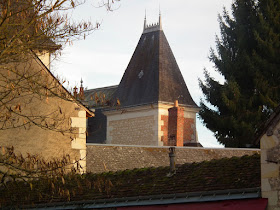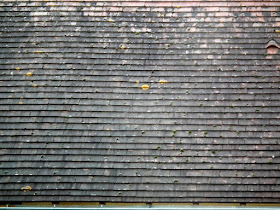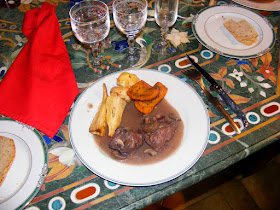Just recently Yohann Sionneau, our local river technician got in touch with me. He'd been reading the blog and thought he might be able to clarify some of the details of what his job entails and how he goes about managing the Claise river and its tributaries. Specifically he wanted to talk about how he has to tread a fine and diplomatic line between a number of stakeholders, and every management decision or action is inevitably a compromise which is the best possible he can achieve after negotiating with the elected officials of the Communauté de Communes de la Touraine du Sud (his employer), landowners along the river (mostly farmers), special interest groups (such as the watermill owners or the anglers associations) and EU regulations (such as the Fresh Water Directive).
 |
Tim suggested the caption for this
photo should be 'The sky's the limit!' He and Yohann are talking
about how Tim manages his site in the Aigronne valley. Yohann was
extremely complimentary, referring to it as the 'lungs' of the
valley. More or less the whole valley has been declared a ZNIEFF, but
Tim is one of the few landowners taking the conservation of the
protected area seriously. Yohann appreciates that greatly.
|
When he was studying ecology he naively thought that when he graduated his job would be to get out into the field and practice ecology. It's been rather a rude awakening to realise that ecology is about 20% of his job. The rest is administration (office based paperwork) and local politics. He commented that admin and politics were not even touched upon in his university course. He's not the only river technician to make a similar remark to me. These young guys (all the ones I know are male) started in their newly created river technician jobs in 2011 full of idealism and zeal. Very quickly they've discovered that not everyone they needed to influence, advise and work with had an approach or ideas that coincided with theirs. It was a crash course in realpolitik that continues to this day. Luckily the rewards and satisfactions of the job still outweigh the frustrations I think.
 |
This is part of a millstream flowing
through friends Tim and Pauline's property. The millstream itself is
owned by local farmer Richard. He and Tim have discussed dredging the
far side of the stream to improve habitat and flow. Mention of that
set Yohann's alarm bells ringing slightly and he requested that if
any work is to be done that he be contacted. He thinks it is probable
that the millstream is classified as a cours d'eau ('water
course') which means that permission must be sought from the
authorities (ONEMA
- Office National de l’Eau et des Milieux Aquatique –
National
Agency for Water and Aquatic Environments).
He can
act as an intermediary with this.
|
Yohann's job is to improve and maintain the health of the rivers in the Claise valley catchment area. He is responsible for 312 km of water courses, including the main tributaries of the Claise, the Muanne, the Aigronne, the Rémillon and the Brignon. His role is a combination of practical field work such as
surveying fish populations and providing the labour and equipment for lumberjacking and earthmoving, as well as advisory, where the landowner wishes to undertake the work themselves. He began by compiling a hefty report on the state of the rivers in the system, and as the first five year plan comes to an end, he is documenting progress and outcomes. The next five year plan is in the pipeline and will be at least as thick as the initial one. Its focus will be on pollution, particularly agricultural runoff and silt, as well as maintaining all the gains of the previous five years.
 |
A weir on the Aigronne River. Yohann
plans to repair it with a light touch, strategically dropping a few
locally sourced rocks in the river to form a series of stepped pools
so that trout can continue to move up and down the river.
|
The first really obvious action Yohann took was to contact landowners with proposals to selectively clear vegetation along the river banks. He hoped this would be a way of building trust between himself as an ecologist with an eye on the big picture health of the river and the mostly conservative private landowners involved in agriculture along the river. As it turned out, sometimes it worked, sometimes it didn't. He is hampered by mostly only being able to provide advice with no powers of compulsion, and by the way the project is funded, where landowners can unwittingly be rewarded for either ignoring or misinterpreting his advice and removing desirable riparian vegetation, both living and dead. There is an unfortunate predisposition on the part of many French landowners to want everything tout propre (all clean and tidy), which is not helpful when it comes to managing and maintaining biodiversity.
 |
A map showing how much the course of
the Claise has been canalised and straightened at Chaumussay. The
blue indicates the old course of the river, the red the modern
straightened course. I have to admit, I can't work out which section
of the river this is (I can't find the Moulin de Benais on
Géoportail). Yohann remarked that between Chaumussay and Le Grand
Pressigny the river is exactly as he would want it to be, but nobody
gets to see it because the banks are not accessible.
|
Part of Yohann's job is to identify trees and vegetation that needs to be removed from the river banks, but also to identify vegetation that is beneficial to the health of the river. The removal of trees should be done on a case by case basis, generally speaking only removing trees that are unstable and constitute a risk. He has poplar plantations in his sights because they are often planted too close to the banks, and with their regimented rows and shallow root systems are
very susceptible to wind damage. If uprooted there can be damage to the river banks, leading to them becoming destabilised. They are also often not harvested in a timely manner and get too big and old, leading to even more likelihood that they are unstable.
 |
Tim F and Yohann discuss river
management where the Aigronne River has been divided to form a
millstream going off to the right and the main course of the river
goes off to the left.
|
Having learnt a lot about communicating with landowners Yohann is now focusing on some other ongoing aspects of the rivers' management. One is the control of the invasive species* such as
Water Primrose, and periodically his team physically remove as much as they can from sections of the river. Second, he is monitoring the fish stocks and is hopeful that the Federation of Anglers can be convinced not to release any more captive bred trout into the river. His surveys show that 17 out of 21 trout caught are wild born and he feels that the wild population should be allowed to build up without competition from the annually dumped captive bred fingerlings. Third, he feels that much of the river is too wide, canalised and slow flowing. He wants to makes sure the tributary rivers particularly become sinuous, bubbling and oxygenated. The trout in the Rémillon and the Aigronne will benefit from this.
 |
A typical example of poor agricultural
practice along the Aigronne River. The field in the foreground was
until last year a water meadow, with pasture for grazing animals, and
a large population of the rare and protected wild flower Snakeshead Fritillary
Fritillaria meleagris. Now the grass has been ploughed up, presumably
to grow a cereal crop, and all the trees have been felled along the
river bank, probably because they shaded the field and would
interfere with cultivating a crop. This farmer can expect the banks
of the river to start eroding and a build up of silt and pesticides
in the river due to runoff from the field. Despite the plant and the land's protected status nothing can be done to stop the farmer engaging in 'normal agricultural practices', a category which is specifically exempt from the protection legislation.
|
To achieve the last aim he has a cunning plan which he hopes farmers will be only too happy to help with, since he is willing to buy field stones which the farmers would otherwise see as a nuisance and pile up to one side. He wants to dump the field stones, which are identical to the stones already in the rivers, at strategic points in the river to act as banks and bars, forcing the water to twist around them and bubble over them. To a large extent he is set on undoing major canalisation work that was undertaken in the 1960s. Prior to the modifications in the 1960s these rivers flooded to some extent every year or so. Riverside landowners were used to it and expected it, but the works in the 1960s were designed to eliminate these floods. They were very successful at doing so, and landowners became less habituated to maintaining water meadows and suitable trees along the river to mitigate the effects of flood such as erosion of banks and the depositing of silt. Now that the river didn't flood they felt safe to plough up the meadows. Cattle grazing was less financially rewarding that cereal growing. Some of them stayed livestock farmers, but more and more the animals were kept in sheds and fed cereal grown on land that was once down to pasture that the animals would have grazed. Others switched outright into cereal growing as their source of income, and either way the river flats were ploughed up.
 |
Yohann with his mahoosive report on the
Claise River.
|
This year, with the
biggest flood since records began in the Claise valley, farmers lost their crops on these riverside parcels. Plus a lot of their soil, fertilizer, fungicides and insectides will have been washed down the river and the banks undermined by the increased flow. If the land had been still just growing native unimproved grasses, the land would have been able to sponge it up, the plant roots would have held the soil in place and filtered out any chemical runoff.
The European Fresh Water Directive was issued in 2000 and the stated aim was that 100% of European rivers should be in good health by 2015. Despite the best efforts of professional ecologists like Yohann this just hasn't happened. The percentage of rivers that have met the targets is currently under 20%. The budget for the Claise and its tributaries over the last 5 years was 1.85 million euros. The budget is divided into three main categories. Heavy works such as the removal of Water Primrose, river bank vegetation, depositing field stones, removal of the old public swimming pool in the river at Le Grand Pressigny and the restoration of the site, fencing and stock watering facilities consumed 1.064 million euros. Another €261 000 was spent on outreach, and finally €95 000 on biodiversity surveys.
The problem is proving complicated not so much on an ecological level, but on a psychological level. The project is necessarily extremely consultative and the stakeholders have a wide variety of backgrounds, concerns and motives. In the long term it will only succeed by continuing to be consultative in this way, but this method of working is slow and can be frustrating for observers and stakeholders alike. Yohann needs to keep a clear head and an even temper. He tells me that certain people who disagree with his approach have insulted him to his face. This is a small community where people tend to know one another and have a personal relationship with their elected councillors. Yohann needs to be aware of local sensitivities and relationships which may have no obvious link to the project but may still influence outcomes.
************************************************
*The Communauté de Communes is also funding
control of introduced aquatic rodents (coypu and muskrats) and
Asian Yellow-legged Hornets as part of the rivers project. They have purchased 100 traps and provided training for anyone interested in using them to control coypu. Asian Hornets love to build their nests by water and the CCTS will also refund up to €150 on presentation of an invoice to destroy an Asian Hornets nest.
**************************************
For details of our
private guided tours of chateaux, wineries, markets and more please
visit the
Loire Valley Time
Travel website. We would be delighted to design a tour for you.


















































